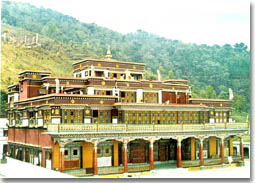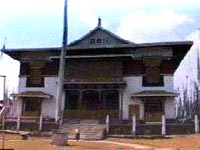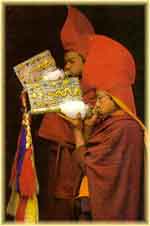| Destinations
|
|||||||||
Sikkim's 194 monasteries or gompas belonging to the Nyingmapa and Kagyu order have not only been influencing the cultural heritage and lifestyle of the people but also demonstrate the ancient rituals in practice. Devoted lamas robed in red, chant ancient mantras to the rhythm of drums and trumpets while soft lights flicker from decorative lamps placed before statues of the great Guru Padmasambhava. Feel the peace and quiet of being one with nature and close to the almighty as sacred words mingle with the whirring prayer wheels. The gompas are adorned with life-like frescoes of hoary Buddhist legends, along with rare silk and brocade thankas. Also preserved here, are ancient Tibetan manuscripts, exquisitely carved woodwork and icons of silver and gold. Rumtek Monastery
|
More about Sikkim • An Overview • Geography • History • People & Culture • Economy • Festivals • Off the Beaten Track • Wild Life • Adventure • Gangtok • Tourist Information • Accommodation • Getting There • Climate • FAQ
Travelogues
Trekking
| ||||||||
Pemayangtse 'Perfect Sublime Lotus' Eighteen km from Gangtok (via Rabongla), this monastery was founded in 1705, during the reign of Chador Namgyal, the third Chogyal. Pemayangste is perched at a height of 2085 metres. It is the second oldest and perhaps the most important monastery in Sikkim. Pemayangtse belongs to the Nyingmapa order and all other Nyingmapa monasteries in Sikkim are subordinate to it. The 108 monks living here are from the Bhutia families of Sikkim. The monastery contains numerous antique idols and objects of worship. The top wooden structure depicting the Maha Guru's Paradise `Sangthokpelri' was completed single-handed in five years by the late Dungzin Rinpoche. Annual 'chaam' dances are performed at the end of February, the 12th month of the Tibetan calendar. Dressed in costumes of rare magnificence, the lamas represent Mahakala and Guru Drag-dmar. The dance ends on the third day with the unfurling of the `Ghyo- ku' - a gigantic embroidered Buddhist scroll, as devotees genuflect in obeisance. Phensang
Ralong Built after the return of the fourth Chogyal from his pilgrimage to Tibet, this monastery belongs to the Karma Kagyu order. His Holiness, the Gyalwa Karmapa performed the `Rabney' (blessing) on its completion from Tsurphu itself, and grains from this ceremony fell on the ground at Ralong. Between 1975 -'81 A.D. the government rebuilt the monastery which today has around 100 monks. The main ceremony falls on the 28th and 29th day of the tenth month of the lunar calendar, when the `chaams' are performed. Phodong Phodong is 28 km north of Gangtok. The original monastery, which was founded in 1740, has been rebuilt. Phodong belongs to the Kagyupa order and has a community of about 60 very friendly monks. Like Ralong and Rumtek, the main annual puja is performed here on the 28th and 29th days of the tenth month of the lunar calendar with religious dances being the main attraction.
Tashiding This gold-topped monastery is built on the top of a hill between the Rangit and Ratong rivers. The main monastery was built by Pedi Wangmo during the reign of Chakdar Namgyalin 1716 A.D. The sacred objects of worship in Tashiding are the chorten Thongwa Rangdol and Bumchu (holy water). The chorten was built by Lhatsun Chenpo and it is believed that merely to view the chorten is enough to cleanse one of all sins. Bumchu is a sacred pot containing holy water that does not evaporate nor spoil and continues remain fresh even 300 years later. The sacred Bumpa containing the water is opened for public darshan once a year on the 15th day of the first Tibetan month. Yuksom (also spelt Yoksum and Yuksam) Yuksom is 35 km north of Pemayangtse. The coronation of the first ruling monarch of Sikkim took place here in 1641. A stupa marks the spot where three lamas performed the consecration ceremony. The wooden altar and throne used in the ceremony are still here. The sacred spot of Yuksom is nestled in a pine-forested area with crystal clear mountain lakes. There are no monks living here and the place is opened only during special Buddhist festivals. Compiled by Romola Butalia
|
|||||||||
Editor: Romola Butalia (c) India Travelogue. All rights reserved. |
|||||||||
 Rumtek Dharma Chakra Centre is 24 km from Gangtok. It was built in the 1960's by His Holiness, the late 16th Gyalwa Karmapa when he took refuge in Sikkim after the Chinese attack. It is an excellent replica of the original Kagyu headquarters in Tibet. It houses some of the world's most unique art objects, ancient manuscripts and icons. About 2 kms away from the Dharma Chakra Centre is the recently rebuilt 300 year old Rumtek Monastery which was originally built by the fourth Chogyal.
Rumtek Dharma Chakra Centre is 24 km from Gangtok. It was built in the 1960's by His Holiness, the late 16th Gyalwa Karmapa when he took refuge in Sikkim after the Chinese attack. It is an excellent replica of the original Kagyu headquarters in Tibet. It houses some of the world's most unique art objects, ancient manuscripts and icons. About 2 kms away from the Dharma Chakra Centre is the recently rebuilt 300 year old Rumtek Monastery which was originally built by the fourth Chogyal.
 His Holiness late Gyalwa Karmapa lived in this monastery till the completion of the Rumtek Dharma Chakra Centre. Today, it is the residence of His Holiness and the headquarters of the Dharma Chakra Religious Centre. The annual dances are held here on the 28th and 29th day of the tenth month of the lunar calendar.
His Holiness late Gyalwa Karmapa lived in this monastery till the completion of the Rumtek Dharma Chakra Centre. Today, it is the residence of His Holiness and the headquarters of the Dharma Chakra Religious Centre. The annual dances are held here on the 28th and 29th day of the tenth month of the lunar calendar.

 Built in 1721, during the time of Jigme Pawo, it was gutted by a fire in 1947, and rebuilt in 1948 through the efforts of the lamas. There are 300 monks in this monastery and the main annual function is held here on the 28th and 29th days of the tenth month of the lunar calendar.
Built in 1721, during the time of Jigme Pawo, it was gutted by a fire in 1947, and rebuilt in 1948 through the efforts of the lamas. There are 300 monks in this monastery and the main annual function is held here on the 28th and 29th days of the tenth month of the lunar calendar.